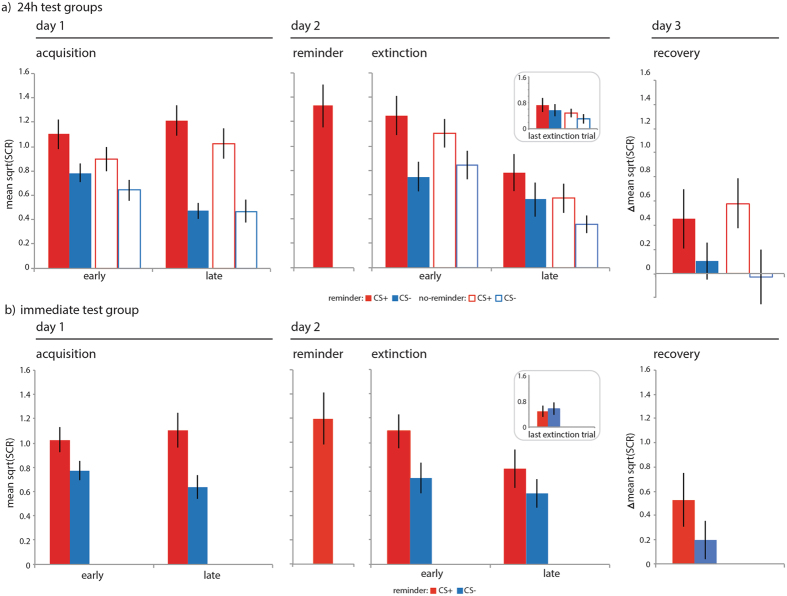Figure 5.
Results skin conductance responses. The aversive Pavlovian category threat-conditioning procedure resulted in the acquisition, retention and extinction of threat-related skin conductance responses. But an isolated reminder before extinction did not prevent the return of generalized threat responses one day later. (a) Reminder group (solid bars, N = 18), no-reminder group (open bars, N = 20), CS+ (red), CS− (blue), error bars reflect SEM. Acquisition (panel 1): Follow-up analyses revealed greater SCR to CS+ than CS− trial during the early phase (CS+ trial 1–5; CS− trial 1–10; t(37) = 4.806, p < 0.001; CS+: 0.994 ± 0.079; CS−: 0.710 ± 0.059) and late phase (CS+ trial 6–10; CS− trial 11–20; t(37) = 8.880, p < 0.001; CS+: 1.113 ± 0.088; CS−: 0.471 ± 0.057) across both groups, and the difference between SCR to CS+ and CS− trials was greater in the late than early phase (t(37) = −4.824, p < 0.001; early phase: 0.142, ± 0.030; late phase: 0.321 ± 0.036). Reminder (panel 2): The reminder trial evoked a SCR. Extinction (panel 3): Follow-up tests showed greater SCR to CS+ than CS− trials during the early phase (CS+ trial 1–6; CS− trial 2–6; t(37) = 5.949, p < 0.001; CS+: 1.1716 ± 0.0958; CS−: 0.7972 ± 0.0826) and late phase (CS+ trial 7–12; CS− trial 7–12; t(37) = 2.974, p = 0.005; CS+: 0.6716 ± 0.0965; CS−: 0.4534 ± 0.0784) across both groups, and the difference between SCR to CS+ and CS− trials became smaller in the late than early phase (t(37) = 1.779, p = 0.083; early phase: 0.3787 ± 0.0629; late phase: 0.2182 ± 0.0734). SCRs were no longer different between the last CS+ and CS− trial of extinction and no differences between groups were detected (CStype (CS+, CS−) × group (reminder, no-reminder) repeated measures ANOVA revealed no main effects or interactions: P > 0.1). Recovery (panel 4): A follow-up test revealed greater delta-recovery scores (change in responses for the last trial of extinction to the first trial of the recovery test) for the CS+ than CS− across both groups (t(37) = 3.422, p = 0.002; CS+: 0.5170 ± 0.1571; CS−: 0.0403 ± 0.1328). (b) The reminder immediate memory test group (lower panels, solid bars, N = 16) also showed acquisition, extinction, and recovery of generalized threat responses. Acquisition (panel 1): Follow-up analyses revealed greater SCR to CS+ than CS− trial during the early phase (CS+ trial 1–5; CS− trial 1–10; t(15) = 3.647, p = 0.002; CS+: 0.1.028 ± 0.106; CS−: 0.774 ± 0.080) and late phase (CS+ trial 6–10; CS− trial 11–20; t(15) = 4.680, p < 0.001; CS+: 1.105 ± 0.141; CS−: 0.638 ± 0.098) and the difference between SCR to CS+ and CS− trials was greater in the late than early phase (t(15) = −2.974, p = 0.009; early phase: 0.254, ± 0.070; late phase: 0.466 ± 0.100). Reminder (panel 2): The reminder trial evoked a SCR. Extinction (panel 3): Follow-up tests showed greater SCR to CS+ than CS− trials during the early phase (CS+ trial 1–6; CS− trial 2–6; t(14) = 3.201, p = 0.006; CS+: 1.0939 ± 0.1405; CS−: 0.7107 ± 0.1270) but not the late phase (CS+ trial 7–12; CS− trial 7–12; t(14) = 1.662, p = 0.119; CS+: 0.7855 ± 0.1575; CS−: 0.5805 ± 0.1160) and SCRs did not different between the last CS+ and CS− trial of extinction (inset; t(14) = −0.425, p = 0.667). Recovery (panel 4): A follow-up test revealed no differences in delta-recovery scores (change in responses for the last trial of extinction to the first trial of the recovery test) for the CS+ than CS− (t(14) = 1.197, p = 0.251; CS+: 0.5261 ± 0.2198; CS−: 0.1965 ± 0.1583). Yet, post-hoc one-sample t-test revealed recovery for the CS+ (t(14) = 2.393, p = 0.031) but not the CS− (t(14) = 1.241, p = 0.235).

